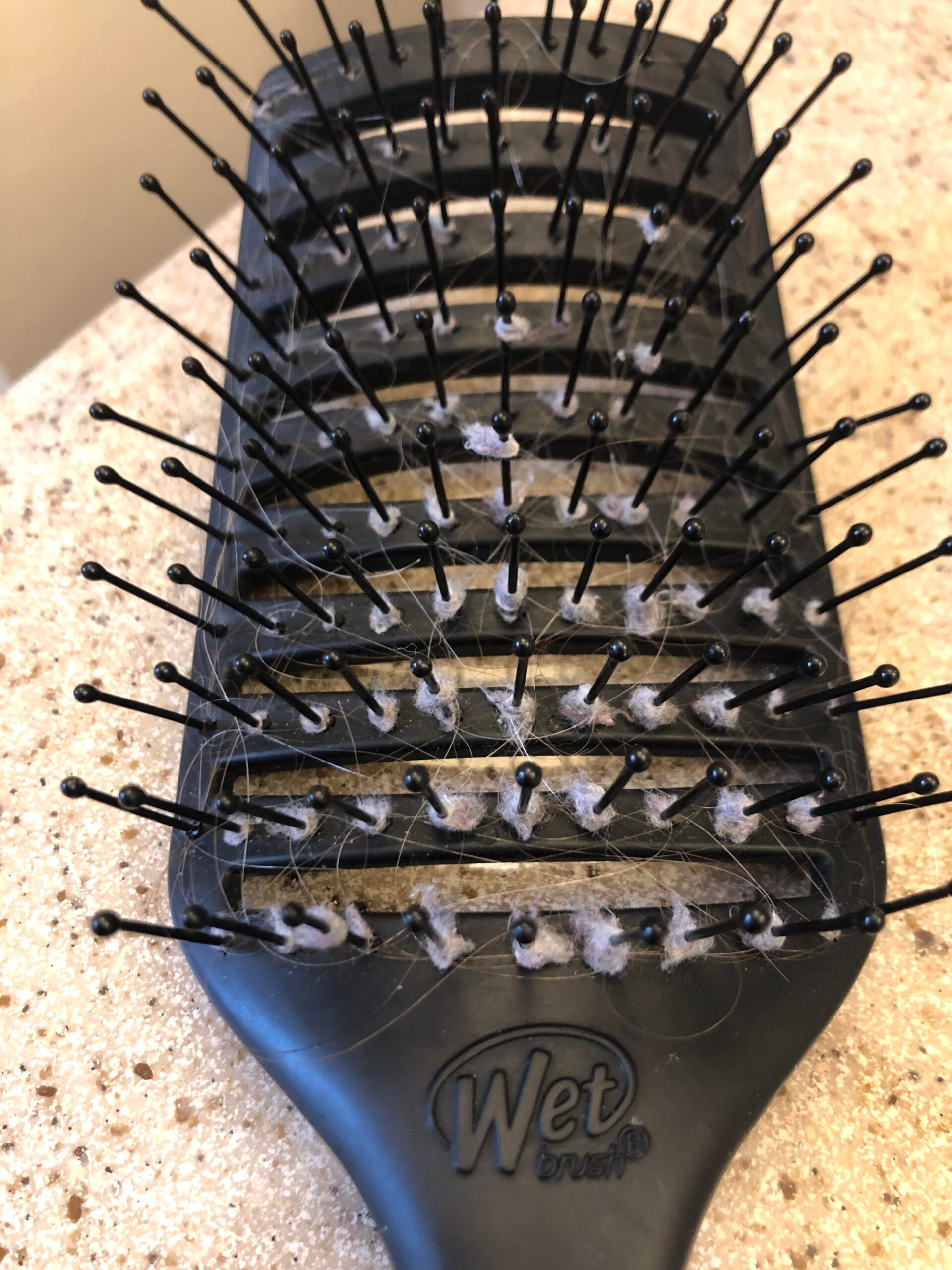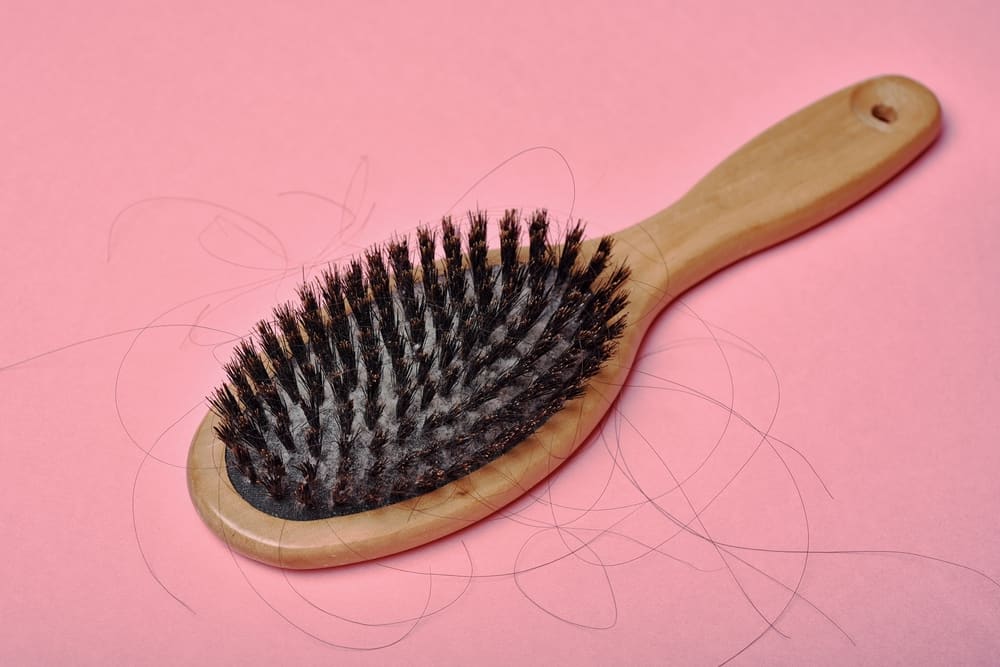Ever glance at your hairbrush and wonder what that gray fuzz is? It's more than just dust bunnies; it's a telltale sign of what your hair encounters daily, and ignoring it could be detrimental to your hair's health.
The reality is that "Why does my hairbrush have dust?" is a common question with a multifaceted answer. It's not just about stray hairs; its about understanding the interplay between your environment, your hair type, and the products you use. The build-up you see is a cocktail of shed skin cells, accumulated oils, airborne particles, and remnants of your favorite hair products. This concoction, if left unattended, can become a breeding ground for bacteria, potentially leading to scalp irritation or even affecting the cleanliness and appearance of your hair.
| Aspect | Details |
|---|---|
| The Problem: | Dust and Lint Accumulation on Hairbrushes |
| Composition of Lint: | Dead skin cells, hair, sebum (scalp oil), dust, product residue, fibers. |
| Reasons for Accumulation: |
|
| Hair Type Influence: |
|
| Product Influence: | Heavy styling products increase residue buildup on both hair and brush. |
| Potential Consequences: |
|
| Cleaning Methods: |
|
| Drying Recommendations: | Place brush on a clean towel with bristles facing down; allow to dry overnight. |
| Brush Type Considerations: | Vented brushes without padded bases dry faster. |
| Frequency of Cleaning: | Remove hair after each use; deep clean weekly or bi-weekly depending on product usage and hair type. |
| When to Replace: | If the brush remains dirty even after cleaning, or if bristles are damaged. |
| Additional Tips: |
|
| Reference | Real Simple - How to Clean a Hairbrush |
One of the primary culprits behind a dusty hairbrush is, quite simply, hair. Each time you brush, strands that have already detached from your scalp, along with broken pieces, get caught in the bristles. These strands aren't always clean; they often carry product residue, natural oils, and dust particles that have accumulated throughout the day. As you continue to use the brush, these elements become entangled, forming a visible layer of lint.
- Kelly Clarksons Wardrobe Malfunction More Shocking Moments
- Yado Yakub More Than Just Margaret Brennans Husband
The environment plays a significant role as well. Our hair acts like a filter, trapping dust, pollen, pet dander, and other airborne particles. These microscopic invaders settle on our hair and scalp throughout the day, eventually transferring to our hairbrush during the brushing process. Individuals with fine hair may notice this more acutely, as fine hair tends to generate more static electricity, attracting dust like a magnet.
Beyond environmental factors, the products we use to style and maintain our hair contribute significantly to brush build-up. Hair sprays, gels, mousses, and even leave-in conditioners can leave behind residue that clings to the bristles. If you have an oily hair type or use a lot of styling products, you're likely to experience a faster accumulation of grime on your brush.
The design of the hairbrush itself can also exacerbate the problem. The bristles, particularly those closely packed together, create a perfect breeding ground for lint and debris. The base of the brush, especially if it has a padded cushion, can trap moisture and further encourage the growth of bacteria.
- Pat Sajaks Wife Inside His Marriage To Lesly Brown More
- Who Is Thijs Lauer Matt Lauers Sons Life Family Today
So, what can you do to combat this dusty dilemma? The first step is regular maintenance. After each use, take a moment to remove any hair that has collected in the brush. For paddle brushes, a long stick or object can be used to gently lift the hair away from the bristles. For round brushes, you may need to use scissors to carefully cut and remove tangled strands.
Beyond daily hair removal, a more thorough cleaning is essential. A simple solution is to wash your hairbrush with shampoo or soap. Fill a basin with warm water, add a small amount of shampoo, and submerge the brush. Use your fingers or a small cleaning brush to scrub away any visible grime. Rinse thoroughly with clean water and allow the brush to dry completely before using it again. Place the brush on a clean towel with the bristles facing down to facilitate drainage. Plan on letting the brush dry at least overnight; vented brushes without a padded base will dry much more quickly.
Some people swear by using a dryer sheet to clean their hairbrush. The idea is that the dryer sheet's fibers will grab onto the lint and debris, effectively removing it from the bristles. While this method may work for some, it's not a substitute for a more thorough cleaning with soap and water.
For brushes with boar bristles, which are known for their ability to distribute natural oils throughout the hair, a gentler approach may be needed. The only way to effectively remove dust from boar bristles quickly is to use a cleaning brush in a quick, sweeping motion. Avoid harsh chemicals or excessive scrubbing, as this can damage the delicate bristles. Then, too, using a bit of water and soap with a cleaning brush every week or so is helpful to stave off too much build up.
Understanding the different types of hairbrushes is crucial in determining the best cleaning method. Paddle brushes, round brushes, vented brushes, and brushes with different bristle types all require slightly different approaches. Choosing the right hairbrush in the first place can also significantly impact the amount of lint you encounter. For example, a brush with widely spaced bristles may be less prone to trapping debris than one with densely packed bristles.
Ultimately, the best way to keep your hairbrush clean is to address the root of the problem. If you have oily hair, consider using a clarifying shampoo to remove excess sebum. If you use a lot of styling products, opt for lightweight formulas that are less likely to leave residue. Regularly wash your hair to prevent the accumulation of dust and debris. And, of course, make it a habit to clean your hairbrush regularly.
If you've tried everything and your hairbrush still looks dirty, it may be time for a replacement. Over time, bristles can become damaged or worn, making them more prone to trapping debris. A new brush can not only improve the cleanliness of your hair but also enhance your overall hair care routine.
I most often find the lint in my hair and the lint I clean from my hairbrush is coloured grey or white and mostly made up of hair and skin particles, sebum and dust. Sometimes colourful pieces of cotton thread get caught in my hair and small pieces of wool fluff. I have long, thick hair to my mid back, and my brush does this all the time. I assumed it was from dust picked up from day to day stuff. Hair is like a filter. But I have no idea how to clean it off. Following this post for the answer. You are not alone.
Each time you use your hairbrush, remove any hair that it collects. As you brush, your brush also collects hair strands that may have product residue or dust on them. The bristles of the brush provide a perfect breeding ground for these elements to cling to, leading to more lint.
Our skin sheds constantly, and these tiny flakes can accumulate on our hair and eventually make their way to our hairbrush. This includes dust mites, pollen, pet dander, and other airborne particles that settle on our hair and belongings. The fuzz on your hairbrush is a mix of dust, fibers, oils, discarded dry skin cells, and styling or hair care products. If it's not regularly removed, it can create bacteria.
Williams agrees, adding that tools are available to help make the cleaning process easier. "Cleaning your brushes regularly keeps the quality of the bristles in better condition," he says.
I have very thick, long, wavy hair and I shampoo twice a week. I keep my hair in a braid most of the time. Every time I brush my hair these lint things come out, and I have no idea from what. My towels are black so I dont think thats it. I remove all hair/lint from my brush after use. Does anyone know what it could be?
So, why is there dust in your hair? Hair can feel and look dusty for a few reasons. This could be because the oil and sebum naturally produced by your scalp attract dust particles and debris, and if you do not wash your hair properly, this builds up over time.
I dont have a brush with a soft rubber inside like that anymore bc it tangled easier for me, but I have a solid bottom brush and I just brush my hair in the shower sometimes (it gets super tangly when I run in hats or the rain or the wind) and it just stays pretty clean bc it gets washed.
- Princes Parents The Untold Story Of Mattie Della Shaw Baker
- Ethan Hawkes Wife The Ryan Shawhughes Story Facts More


